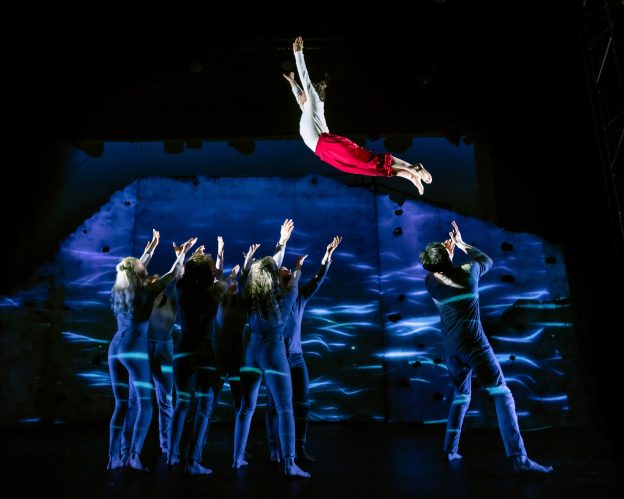The Hidden People is a co-production between British circus theatre company Hikapee and Icelandic theatre company Huldufugl (Hidden Bird). The show combines Icelandic folklore, aerial circus and physical performance, and creative technology.
Here, three different voices offer their individual perspective on the UK premiere of the show, which took place at the Pavilion Theatre Worthing.
Dorothy Max Prior, reporting for Total Theatre Magazine, writes:
Greys, blues, greens – a typical Icelandic landscape of hills and glaciers and rocky outposts. At first, we seem to be looking at a painting that covers the entire back wall; but as the show starts and the landscape shifts and moves, we realise it is a projection – and that the upstage area is made up of a climbing wall construction, which forms the ‘screen’ on to which the cleverly shifting moving images play out.
Throughout the next couple of hours, we are taken to many different outdoor environments – a rolling panorama of verdant summertime hills, black volcanic lava, icy fjords and gorges, flowing waterfalls – and to the hidden nooks in the mountains where The Hidden Peoplelive, often cleverly camouflaged within the landscape/set. More on them anon! The lighting design works with the projection, giving us a visually stunning rollercoaster of images. It could almost be a tourist board advert for the wonders of Iceland.
Within this stimulating environment – created by visual designer / moving image maker Owen Hindley, with a team of lighting, set and costume designers and makers on board – an ensemble of eight performers, drawn from the two collaborating companies, bring us an almost word-free and highly physical tale of difficult decisions around productivity versus preservation, environmental action, and respect for nature.
The Hidden People is the story of two sisters, Rósa and Tinna. They are, at one and the same moment, representations of real people and personifications of the show’s key elements: scientific progress and natural world conservation. Rósa has left Iceland to become an architect and engineer. Her sister Tinna remains behind in the Icelandic countryside, dedicated to the natural world, and respectful of the huldufolk, Icelandic’s hidden people – who are sometimes seen as a kind of elf or fairy, and oft described as like humans but more evolved. They can be seen only if they want to be.
Let me step out of this story for a moment to tell you another story. On a trip to Iceland twelve years ago, I was having dinner with my dear friend Einar, and he was telling me about some problems with the building of his new house. Diggers and other tools and machines kept breaking down. ‘We had to move the road to keep the elves happy,’ said Einar. I laugh – but see that this is no joke, Einar is deadly serious. ‘No really, you must respect the wishes of the huldufolk.’ This is not the only story I’ve heard subsequently about road and house building and other construction plans coming a cropper if respect is not paid.
Back to the show: Rósa has returned to Iceland full of enthusiasm for her latest project, the construction of a large hydroelectric dam. This will disrupt the landscape and local fauna and flora, but on the other hand will provide a significant amount of green energy.
There’s a very lovely scene in which the graphs and blueprints and calculations of Rosa’s plans play out in a shifting medley of projected images whilst she sits to the side of the stage at her desk, eventually arising to interact with the projected imagery, twisting and turning and tumbling as she calculates her way forward.
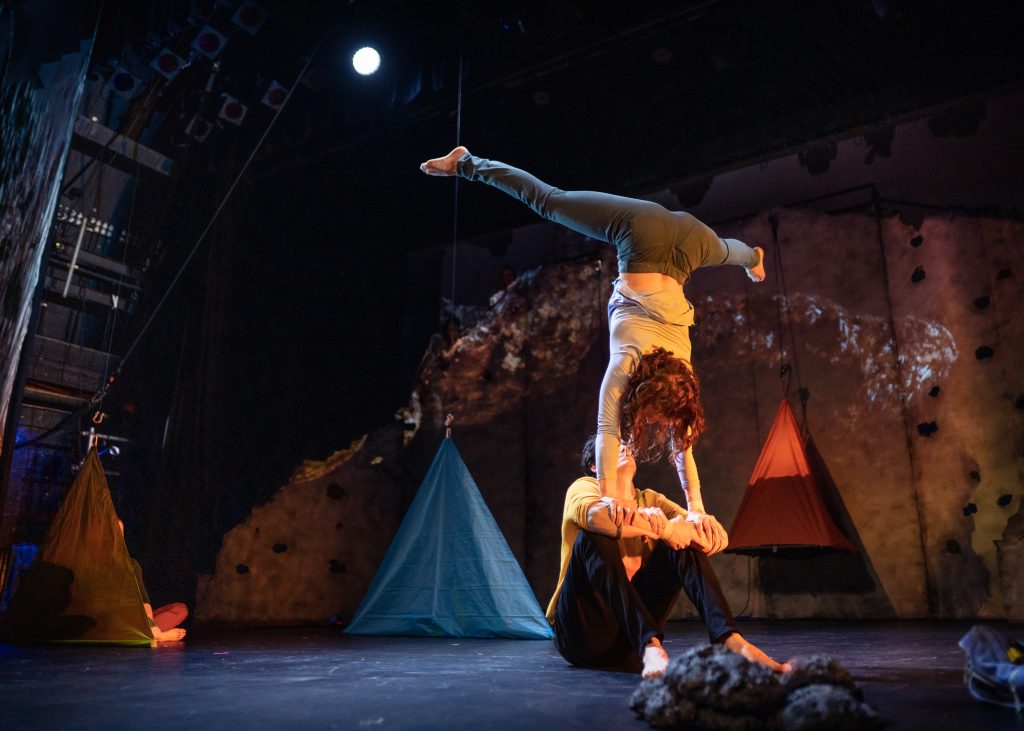
The story evolves in scenes in which the human intellectual and emotional dilemmas – mostly explored through the tussle between the two sisters – are contrasted with the huldufolk’s gently detached relationship with nature as they move organically amongst the rocks and hills, often blending seamlessly into the landscape. That aforementioned back wall structure proves to be an excellent piece of staging/set that can be climbed up, hung from, or abseiled down on bungees.
The show’s writers – Bryony Livesey-Casey (who also directs) and Edd Livesey-Casey from Hikapee (who also performs in the ensemble), and Nanna Gunnars (who performs as Tinna) and Owen Hindley of Huldufugl – have found a nifty way to differentiate the two worlds when the same ensemble cast play everyone and everything: When we are with the humans, it is classic European ensemble physical theatre work that carries us forward (three of the four co-creators are Rose Bruford European and American Theatre Arts graduates), combined with floor-based acro and hand-to-hand; and the aerial equipment comes out when we are in the world of the Hidden People.
A camping-in-the-hills scene, in which the humans pitch tents and do all the things people normally do in tents (I’ll leave this to your imagination), gives the opportunity for some nice shadow theatre work – although this scene does feel a little long; and indeed the show as a whole could do with some trimming. But this is its very first outing in public, so that is to be expected.
There is some very elegant and effective dance-mime work from Sophie Northmore as Rósa, and a great scene in which Charlotte Greenstock performs a powerful solo aerial straps routine as ‘Rósa’s dream self’. The story reaches its apex with a stunning scene set in and around the waterfall – a culminating point where all the best elements of the show come together as the skilful aerial silks work is highlighted by Owen Hindley’s stunning projection. Throughout, this almost word-free piece is glued together by composer Iris Thorarins’ moody and dreamy soundscape.
The ending is ambivalent – but this I like, as it leaves space for the audience to be part of the creative process, as they muse on which reality they wish to believe in… perhaps opting for both simultaneously.
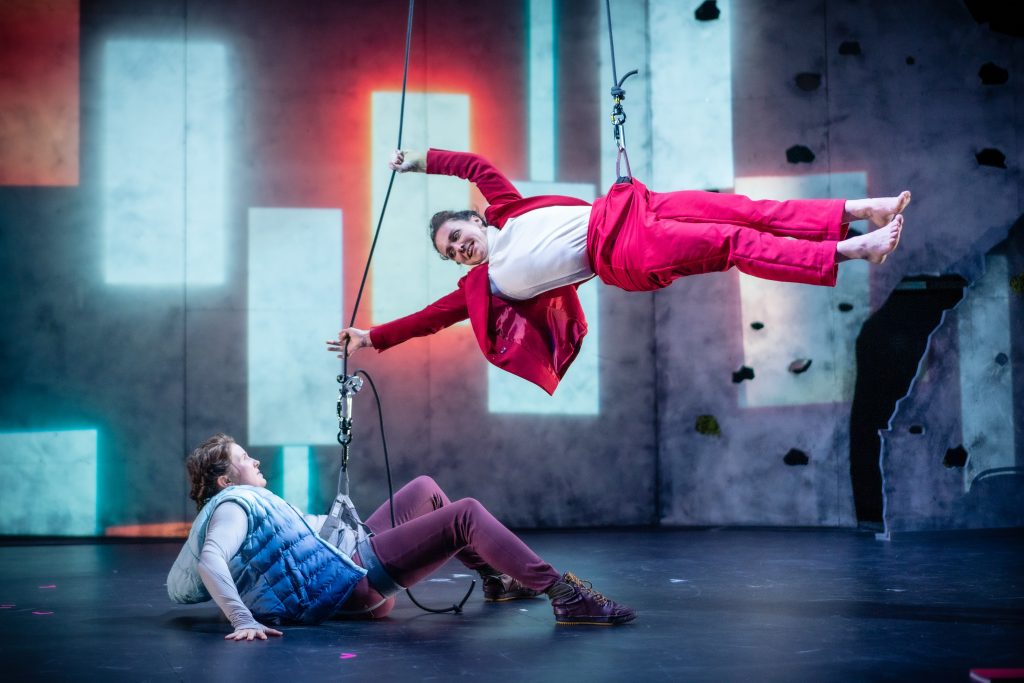
Photo by Robin Boot Photography
Nanna Gunnars from Huldufugl, co-producer and performer in The Hidden People, writes:
Huldufugl fuses physical theatre with creative technology and Hikapee focus on narrative-driven circus performances. Going into this collaboration we knew we wanted to tell a narrative story using circus techniques and be non-verbal in order to reach an international audience. The few words that are spoken are the given names of the characters, all in Icelandic. The initial inspiration came from folklore stories of the Icelandic hidden people – we wanted to explore how we could show something on stage that should essentially be hidden, helped along with an innovative combination of projection, lights and shadow. We wanted to make bodies on stage blend into the background or use them as a part of the landscape, representing the movement of the earth, from rolling rocks to splashing water, using projections to do so. I have a background in physical theatre but the other half of Huldufugl, Owen Hindley, has experience with real-time digital animation and designed the landscape projections, with inspiration from one of Iceland’s most famous painters, Jóhannes Kjarval.
Our approach to making The Hidden People was mainly twofold. We explored a variety of images and ideas that we wanted to create on stage, and separately discussed what kind of a story we wanted to tell. As a part of the image work we created several tableaux from key words, finding combinations that we found striking. Some of the early keywords we worked with were ‘water’ and ‘waterfall’, as Iceland has an abundance of both: we had this idea of our main character being swept away by an onslaught of water. We dove into aerial movement that could indicate falling water, rapids, turbulence, calm, strong currents, whirlpools and drowning. These are some of my favourite moments from the show. I’m the only performer in the show that’s not a circus professional, but I truly enjoy being a part of the ensemble when we embody a violent river that engulfs the lead character, through physical theatre and hand-to-hand acro sequences. Through this collaboration with Hikapee I’ve also learned a lot about circus techniques and how different types of aerial equipment influence the quality of movement. For example, we chose to use aerial silks to signify a beautiful, cascading waterfall, where the performers use a variety of roll-ups and roll-downs to portray the torrents of the water in a graceful manner. For a drowning sequence, on the other hand, we went for aerial straps. Our straps performer, Charlotte Greenstock, was able to perform slow, sinking movements mixed with more violent and thrashing movements between gasping for air.
We also knew we wanted to modernise the hidden people. The idea to reserve aerial equipment only for the hidden people came early, but we also looked at what kind of physicality we could give them. Historically they have been seen as largely like humans but more advanced, resulting in being more skilful, attractive and living in closer harmony with nature – humans 50 years into the future. We didn’t want to give them an overpowering otherworldly quality of movement nor deprive them of individuality, but still portray a different feel from our human characters. We connect the two worlds together by having the hidden people use aerial equipment to swing and glide elegantly across the stage, and the human characters also traversing the stage in midair, albeit using bulkier climbing equipment, harnesses and carabiners, with this equipment on full display.
One of the major characteristics of the hidden people is that they’re seen as one with nature, and in a way, the protectors of nature. Considering how concerned humans are today about climate change and global warming, whilst simultaneously distracted by excessive screen time, we imagined that a few decades down the line people might be more grounded, and better connected with nature and their surroundings.
Water was already a recurrent theme in the story, and we decided on a story about the building of a new hydroelectric dam in Iceland. Even though, for the rest of the world, hydroelectric dams may only seem to be positive as they produce green energy, they are a highly controversial topic in Iceland. There are both positives and negatives, and we didn’t want to dictate what the audience should think but give an ending that can be interpreted in both a realistic negative way, or a more fantastical positive way.
As the only Icelandic performer in the show, I found it important that the whole group would have a sense of how the hidden people are regarded and portrayed in Icelandic society. It was especially important to me not to make a clichéd performance and steer clear of tropes around them, such as making them cute or quirky. I also insisted on involving an Icelandic composer, Iris Thorarins, to get a true Icelandic sound for the performance. I found it very interesting and somewhat challenging to stage Icelandic identity in a production that’s predominantly British. All in all I think we succeeded in creating characters that would fit well into Icelandic society and make a modern version of the often-dated hidden people, I might just add on a masterclass in Icelandic language pronunciation before the next show!
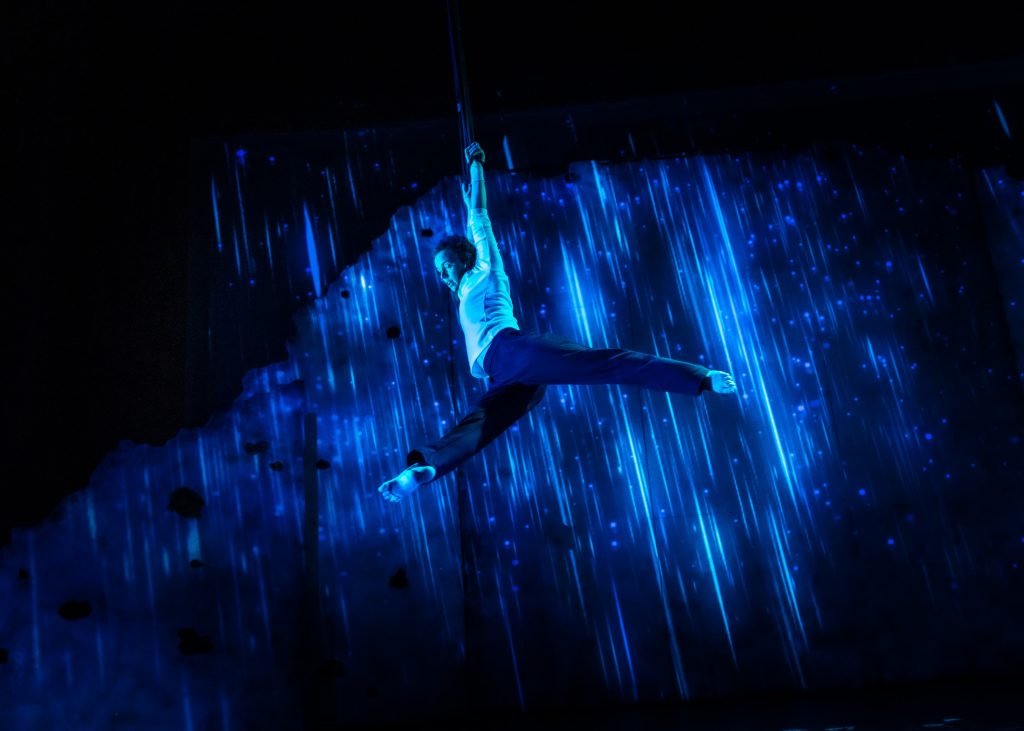
Aerialist and ensemble performer Charlotte Greenstock writes:
I am a circus performer specialising in aerial straps (two long straps with wrist loops on the end). Hanging from the straps, I use a combination of strength and momentum from spinning to create dynamic sequences.
My roles within The Hidden People were to embody the architect Rósa’s nightmare, to work as part of the ensemble, and to cause mischief as one of the hidden people.
Creatively, developing the nightmare scene (playing lead character Rósa’s dream self) was a really interesting experience, as lots of different elements and many people were involved to pull the scene together. I worked closely with Edd Livesey-Casey (my counterweight) to utilise the counterweight system fully and take up as much space as possible. Alongside this, Owen adapted the projections to work with my movements to create a drowning effect.
Even though I appear to be alone on stage at this point, I’m not – aerial straps often involves working closely with another person. Edd had to know my movements and cues exactly, in order to lift me at the right time and lower me safely. This scene in particular was a challenge. It was difficult to create the frantic effect desired, as I often didn’t land on my feet, or would land and continue moving around the space. Edd was an intuitive counterweight, and I am incredibly pleased with the piece we created together.
During this nightmare scene, I felt very connected to the cast. At the start, I’m carried on and gently placed on the floor by another member of the cast, then Edd lifts me slowly to begin the scene. We work together, and at the end I am carried away again. Being held at the start and at the end was an emotional experience which helped me to connect with the helpless state my character was in.
Alongside my ‘nightmare’ role, I am also an ensemble performer in the show and portray one of the hidden people. I knew little about Icelandic folklore before this experience, so it’s been really interesting to immerse myself in something completely new.
Throughout the creation period, we were each encouraged to find and connect with our ‘hidden person’ character. We played and explored in various ways until each person’s individual character started to emerge. Different parts of ourselves were exaggerated through our hidden people. I ended up high energy and mischievous, Katie (Hardwick) graceful and serene, Lawrence (Swaddle) cheeky, Edd provocative etc. We had a lot of fun discovering these versions of ourselves and took time to play with who we thought our characters could be. For me, this involved a lot of running around and chasing people!
For some reason, I don’t usually get nervous when I perform. Although in this case, there were lots of moving parts to bring this show together, and missing my cues could have a knock-on effect for a lot of people. So I definitely had some nerves as the performance began! Fortunately, as a cast, we fell into a familiar rhythm, and feeling it all come to fruition was very satisfying. I’m going to miss this crew and this creation, but hopefully we will all be reunited next year to play as hidden people again…
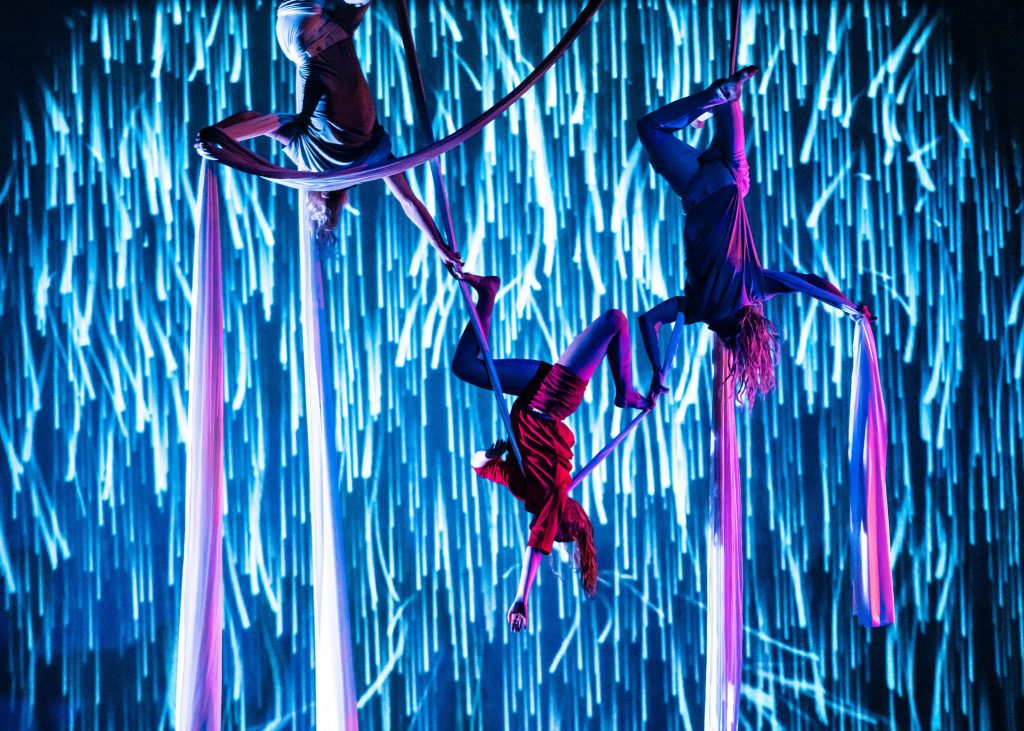
Featured image (top) and all above images: Hikapee Circus Theatre and Huldufugl: The Hidden People. Photos by Robin Boot Photography.
The Hidden People is a co-production between British circus theatre company Hikapee and Icelandic theatre company Huldufugl (Hidden Bird).
The Hidden People premiered at Pavilion Theatre, Worthing on 12 March 2022, and will be touring 2022–2023.
For Hikapee Circus Theatre see: http://www.hikapeetheatre.com/
For Huldufugl see http://www.huldufugl.is/
More about creating The Hidden People and the issues inspiring the show:
On the issue of hydraulic dams: Iceland is the world’s largest electricity producer per capita, with approximately 55,000 kWh per person per year. There is an abundance of natural energy to be had in Iceland, and plans for several more dams currently exist. If they go through, they will create hundreds of jobs in rural areas. However each dam has an enormous effect on wildlife habitat, not to mention the extreme change in the landscape. Icelanders pride themselves on their unspoilt nature, which in turn draws in large numbers of tourists every year. However, Iceland is also the largest green energy provider per capita, and the country’s total electricity consumption is almost 100% renewable. So the issues are complex.
The Hidden People was supported and developed in partnership with a number of UK organisations. The final creation period took place from January-March 2022, at Out There Arts (Great Yarmouth), The Point (Eastleigh) and Pavilion Theatre (Worthing).
The show are grateful to have received funding from Arts Council England, Nordic Culture Point, Nordic Culture Fund, The Finnish Institute in UK and Ireland, The Icelandic Embassy in London, and RUV & Stef Composer Fund. Additionally, the show received support from Jacksons Lane Theatre, 101 Outdoor Arts and Iðnó during the rehearsal process.
The show’s makers would also like to thank Terry Gunnell, a professor and world authority on Icelandic folklore, who was interviewed in the early stages.

